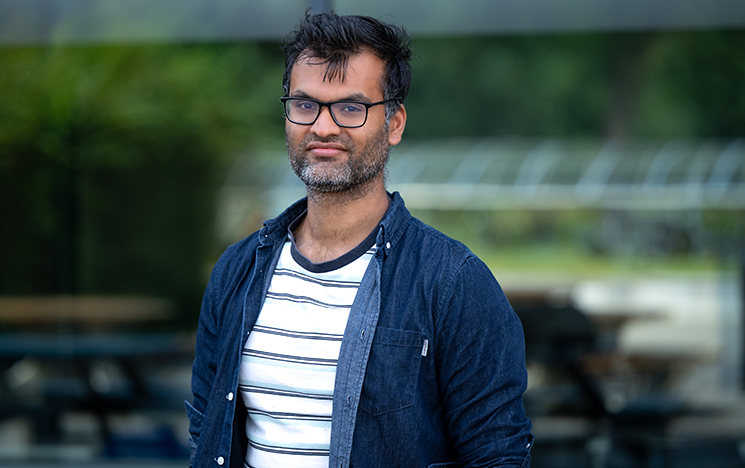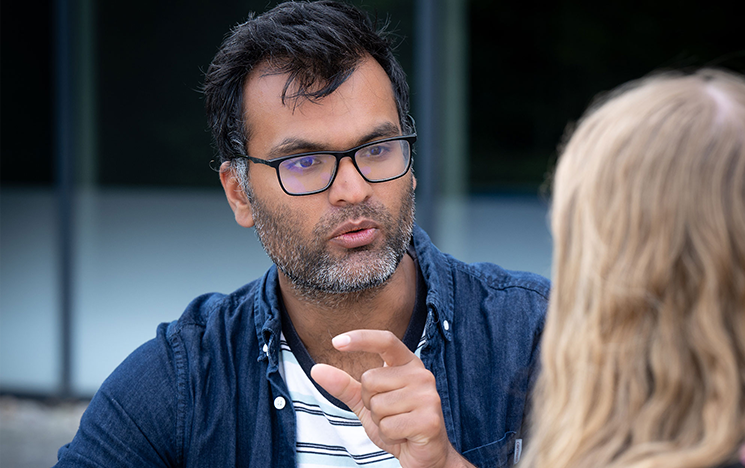Understanding the brain through bio-inspired learning - an interview with Dhruva Raman
Formed from billions of cells, our brains offer many profound mysteries. How do the elements of such a complex structure work together, and how do they shape the way we learn?

Introducing...
For Dr Dhruva Raman of Sussex Artificial Intelligence (Sussex AI), one of our 12 Centres of Excellence, considering the brain through the lens of design principles is key to enhancing our understanding.
Working with data gathered from fruit flies, Dhruva’s work brings together insights from biology and technology to spot patterns in the formation and behaviour of the nervous system – ultimately helping us to better understand how form and function connects in our own.
We caught up with Dhruva to discuss how he takes an interdisciplinary approach to his work, why fruit flies offer a deep-dive into our own brain structures, and how life in the South Downs can inspire new ideas.
How would you define your area of specialism?
Our nervous systems are complicated. The simplest organism we research in neuroscience is a microscopic worm called Caenorhabditis elegans (C. elegans) which only has around 300 neurons - and even then, we don’t fully understand how its brain works. Brains are also highly structured - different regions have completely different architectures. I’m trying to understand how differences in design between regions provide insight into the types of information processing that they’re particularly good or bad at doing. This helps us with the more difficult task of modelling how they work together to achieve a particular behaviour.
For instance, one project relates to flexibility - a key difference between biological and artificial intelligence (AI). When faced with situations that demand new strategies, animals can ignore and overwrite what they’ve previously learned. I’m interested in asking questions like: what neural design features would be good at this and why? How do these differ from AI learners? Why could this explain behavioural diversity?
As dry lab neuroscientist, I build computer-generated models to explore how flexible behaviour is embedded in the neural structures of organisms ranging from fruit flies to humans. Essentially, I’d say my work aims to uncover hidden neurological design principles that wouldn’t be obvious just by looking at samples and data.
By uncovering these shared design principles, my work aims to help us understand the evolutionary logic of behavioural diversity.” DR Dhruva raman
Lecturer in Computer Science and AI
Have you always been interested in neuroscience, or has this grown over time?
My parents are both in the medical field, so I chose to do something a bit different and study maths. This was when Big Data was really beginning to enhance our understanding of cells and physiology, and I was inspired to begin a PhD in Systems Biology, where I could explore how cells fit together to create functioning organs.
However, biology was messy and complicated in a way I wasn’t used to. I couldn’t build nice, clean theories from first principles like I did in maths, so I pivoted to Control Theory - an area of engineering that explores how we can design more robust systems for things like aeroplanes.
After completing my PhD, I had a chance meeting at a conference with a neuroscientist. He was trying to understand Control Theory because brains have similar reactions to changes in their environments, and he also happened to be offering postdocs. I’d always been interested in the brain, so I thought: ‘Why not take a step in the dark and move into neuroscience?’
As time goes on, I feel I've finally come to love the messiness of Biology.
What are the key themes guiding the direction of your work?
Many strands of neuroscience focus on trying to understand how we learn, and how neurons inside the brain change and rewire themselves to support that learning. We do this by using data on animals in fixed experimental tasks which differ from the unpredictable, naturalistic environments they’ve evolved in. I’m always looking to bridge that gap.
Fruit flies have a fairly simple nervous system – technically, it’s still fantastically complex, but it has around 100,000 neurons compared to humans, who have around 80 billion. There’s also a huge amount of existing research devoted to mapping out their brains, which gives us a solid foundation to work with. We can observe which neurons are firing and when, which isn’t really possible in other creatures.
An individual fruit fly seems to have multiple internal personalities which learn in different ways from the same experiences. This seems unusual for such a tiny, energy-constrained organism, so I’m trying to unpick why this might be.
Obviously, insects are different to humans in many ways, but there are remarkable similarities between the structures of their brains and how they learn to those of vertebrates, mammals and, ultimately, us. Understanding questions in relation to fruit flies’ brains might translate to similar structures in ours, which would have profound implications – not only by helping us to better understand ourselves, but also how similar design principles can be adapted to improve systems across technology and engineering.
Neuroscience is a steadily evolving field – what does this mean in the context of your work?
Neuroscience can feel new because we haven’t discovered what everything in the brain is or looks like yet.
I often use the analogy of a caveman trying to explain a Ferrari – they wouldn’t know what certain components are, and and trying to model how everything works together would be impossible for them. However, as humans, we can look at a sports car and a lorry, or a dolphin and a shark, and notice how different their shapes are. While we might not understand exactly how they work, we can guess that each design serves a different purpose.
I’m trying to make a difference in this sea of ‘not-knowing’ by enhancing our understanding of design principles, function and form. I look for insights at a conceptual level, because these can help us make comparisons more easily.

What originally drew you to Sussex, and why is it important for you to conduct your research here?
After completing a postdoc at Cambridge, I wanted to move somewhere new. Sussex is definitely unique compared to the places I’ve been before. Some research environments pressure you to follow the latest fads, but here, I’m surrounded by people who are pursuing more unconventional ideas. You’re encouraged to take your time and ask questions that align with your own interests.
The geography of campus also means that it’s easy to connect with colleagues across different departments. Our community is really strong - I can just head over to Life Sciences, for example, and chat with colleagues over coffee.
Why is collaboration so important to developing your work?
Sharing ideas in an open environment sparks interesting ideas and perspectives. By hearing what people have to say about your research, you can use their insights to make it better.
It's also nice to be surrounded by people who are researching organisms in their natural environments, like bumblebees in the Downs. This pairs nicely with those of us who focus more on data and lab conditions, and has helped me learn about creatures and their everyday lives. My mind was blown, for example, when I learned about bees and their dances: after they’ve foraged for nectar, they return to their hives and communicate all sorts of detailed information around where flowers are and what they’re like by dancing. How amazing is that?
Alongside my research, I really enjoy supporting students and early-career researchers. I want to understand where they’re coming from, which questions they’re trying to answer, and how I can help them reach where they want to go. Feeling like I’ve helped someone realise something – or even just have a bit less angst about what they’re doing – is important to me.
What advice would you give to people who are interested in pursuing neuroscience or research more broadly?
Focus on exploring naive, interesting questions. You can answer them as you go, so don’t worry about needing to learn lots of stuff before you’re qualified to start asking things.
Also, don't defer to the authority of existing work. Simplifying things down to general assumptions can help you get a sense of useful theories and findings - even if something is written in a 'bossy’, authoritative way, that doesn’t mean it’s completely true. There’s a reason why scientific consensus tends to change every decade or two!